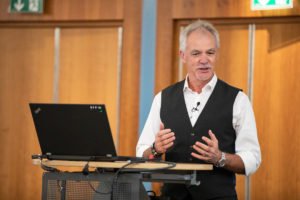John Green, Health and Safety Director at AECON, rounds off his Safety Differently series by looking into the future.
To read the first part of this article, click here and, Click here for part two.
 Achieving a philosophical shift is crucial in shifting the safety paradigm successfully. Organisations that take on the ‘New View’ without truly understanding the base shift in thinking will struggle and many will fail. Without doubt there will always be an appetite, sometimes overwhelming, for the tools. Our employers are impatient, our project leaders what to know what to do, what tools to use and they want to know now.
Achieving a philosophical shift is crucial in shifting the safety paradigm successfully. Organisations that take on the ‘New View’ without truly understanding the base shift in thinking will struggle and many will fail. Without doubt there will always be an appetite, sometimes overwhelming, for the tools. Our employers are impatient, our project leaders what to know what to do, what tools to use and they want to know now.
I can’t overemphasize just how important it is to socialise these ideas before launching into a full-blown implementation. This is where ‘micro experiments’ come in – they are relative low risk ways of testing the water.
Micro experiment is the vehicle being used to make this happen. There are some rules about when you should and shouldn’t use them. Most ideas don’t work the first time you use them, so micro experiments make failure more manageable and allows the workforce to become involved in the process. It’s key that they are not used when an error could lead to a disaster or you want to understand why something happens.
Many organisations are now on a journey where they become willing to accept that errors do happen: practice is not perfect, risks have to be taken. This obviously clashes with a vision of zero-harm (which indeed is more of a vision than a realistic goal). A couple of things happen with a lavish commitment to zero-vision and the idea that errors do not happen:
– People will be motivated or incentivised to hide errors and their consequences. This creates shame and guilt and stigmatises both error and those involved;
– All incidents, no matter how small and inevitable, were once likely to be investigated without regard to their relevance, impact or inevitability, potentially distracting and wasting resources that are better spent on deeply analysing “the incident of the month” for example;
– Learning and improvement can be eroded by a zero vision, as it is based on having nothing negative happen. With nothing happening, what is left to learn from? Resilient organisations do not focus on reducing backward-looking negative events, but on the positive, forward-looking capabilities of people and teams to recognise, adapt and absorb even those challenges that lie outside the predictable scope or design envelope. As a commitment, zero visions are not necessarily harmful (just like commitments to a healthy lifestyle or successful marriage), but as an assumption of statistical probability, they become nonsensical and translate into unrealistic and possibly counterproductive policies.
Similarly, this journey requires the acknowledgement that distant, administrative control of safety practices are not generating additional returns on investment. They seem ready for devolving power back to the projects. This involves trust on part of leaders to give this power back, and confidence on part of the projects to receive it. It has implications for supervisory skills and middle-management skills.
What is the practitioner’s role in all of this?
 Traditional thinking would suggest that it’s to lead alongside the other senior leaders. Safety is after all a leadership issue. Be strong, lead from the front, do the right things.
Traditional thinking would suggest that it’s to lead alongside the other senior leaders. Safety is after all a leadership issue. Be strong, lead from the front, do the right things.
I understand the seduction of this approach, but I can’t completely agree with it. To me this simply reinforces the traditional power gradient in organisations. ‘I will lead you will follow, I know best you do as I tell you’ – is no maxim with which to advance an agenda forged in empowerment and collaboration. Far better to create an environment that fosters, nourishes and supports the creation of safety, an organisation that hosts safety, that allows roles to change, that promotes ask over tell and relationships over task is far more likely to succeed in the long run than one that believes its leaders have all the answers. Leading Safety Differently is about having the courage to realise that the answers are there to be found, often in the workforce, but that we, the leadership don’t have them. Acknowledging that we don’t need better answers we need better questions. This requires a lot of people to suspend a lot of egos – but unless we create the pathways that allow us to be surprised then little is going to improve. Leaders need to be able to read systems and to see interactions and emergence, to pick up weak signals. Normally they are not very good at this as they may have designed the very systems that they are interrogating or have fixed, preconceived notions about how they should operate.
People need to once again engage with the work they are about to undertake and not with the systems that are designed to control it. The bureaucracy that has been created not only produces a huge performance drag on organisations it also restricts the mental agility of those it is meant to help.
New era
We need a new era in safety, a new era where human beings create safety. Continuing to do what we have always done is not going to lead to different outcomes and it is unlikely that we can break through the asymptote on safety progress with them. We should not of course simply abandon everything we have done so far. Much of it has been highly successful and productive in reducing unnecessary injury and whatever we do moving forward cannot be at the expense of increasing injury rates. But we must realise that that it will do little more than hold us steady.
New technologies may hold the answer, but they also run the risk of introducing more complexity. But there are also other avenues that will allow us to govern Safety Differently.
This new era then calls for a form of governance that sends power over many decisions back to the shop floor back to the projects. It realises that people exist as a source of diversity, insight and wisdom about safety, not purely as sources of risk. It calls for governance that trusts people and mistrusts bureaucracy. It will take time, we are part of a larger system that feeds the bureaucratic beast. But it is something that must be done.
It is only right that the profession should examine and assess the tools that it has at its disposal and if these tools are no longer appropriate for the challenges that we face we must have the courage to leave them behind no matter how well they may have served us in the past and move forward with a different approach.
The future
We have very real opportunity to make a huge difference. To contribute to the 4th Industrial age and to become real partners in both advancing our cause but also in contributing to the success of the enterprises that employ us.
The future can be what we want it to be – for us its either a blank canvas upon which we can craft an unbelievably creative profession or it’s a black hole sucking in all the motivation, aspiration and energy of each and every one of us.
When I try to imagine what this profession might look like in five or 10 years I am amazed at just how cool, how interesting, how valuable and yes how sexy safety could become.
Anything less will see safety becoming increasingly irrelevant and marginalised as the industrial world moves forward and we will still be focusing exclusively on the negatives for decades to come. Wondering why we have not made the differences that we all wish to make.
John was speaking at the 2018 EHS Congress in Berlin, in November.
The Safety Conversation Podcast: Listen now!
The Safety Conversation with SHP (previously the Safety and Health Podcast) aims to bring you the latest news, insights and legislation updates in the form of interviews, discussions and panel debates from leading figures within the profession.
Find us on Apple Podcasts, Spotify and Google Podcasts, subscribe and join the conversation today!

 Achieving a philosophical shift is crucial in shifting the safety paradigm successfully. Organisations that take on the ‘
Achieving a philosophical shift is crucial in shifting the safety paradigm successfully. Organisations that take on the ‘ Traditional thinking would suggest that it’s to lead alongside the other senior leaders. Safety is after all a leadership issue. Be strong, lead from the front, do the right things.
Traditional thinking would suggest that it’s to lead alongside the other senior leaders. Safety is after all a leadership issue. Be strong, lead from the front, do the right things.